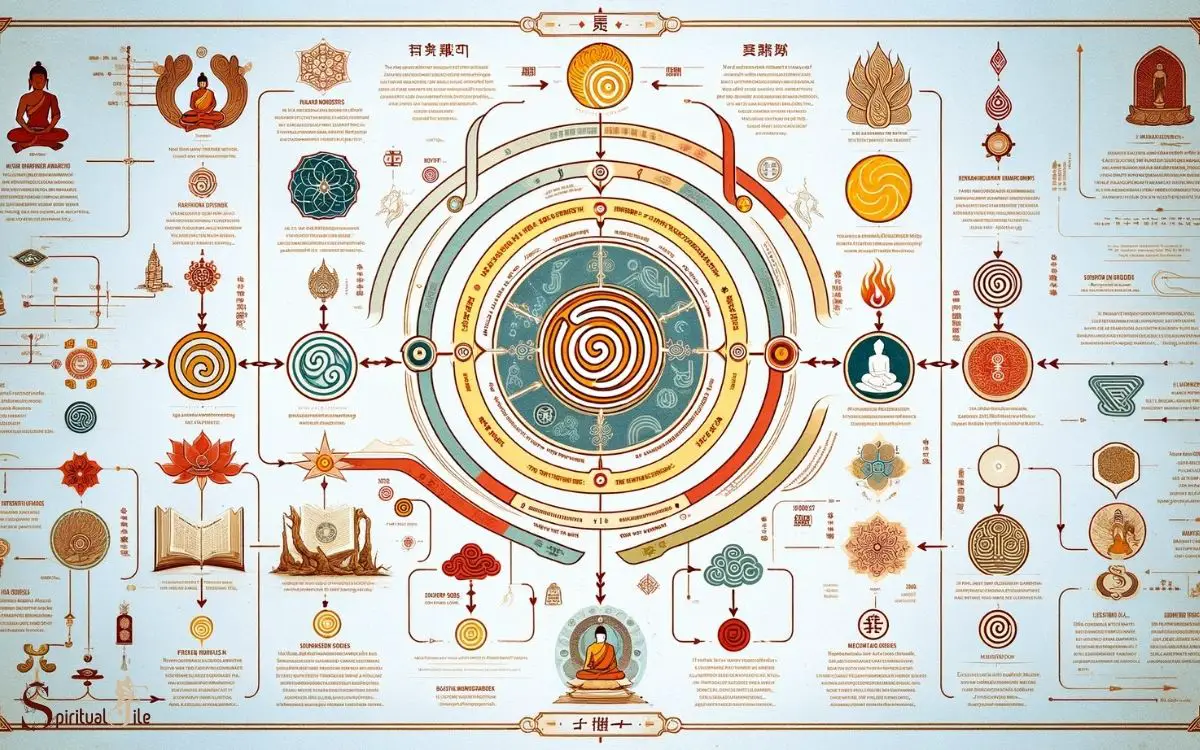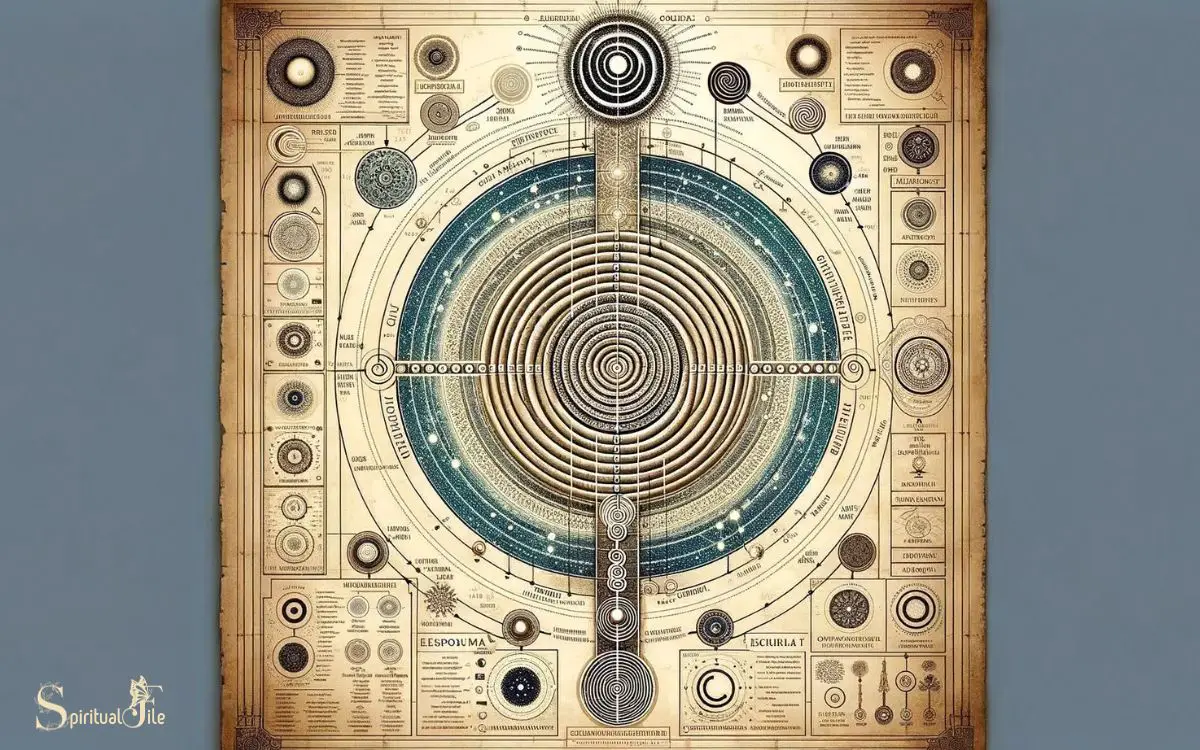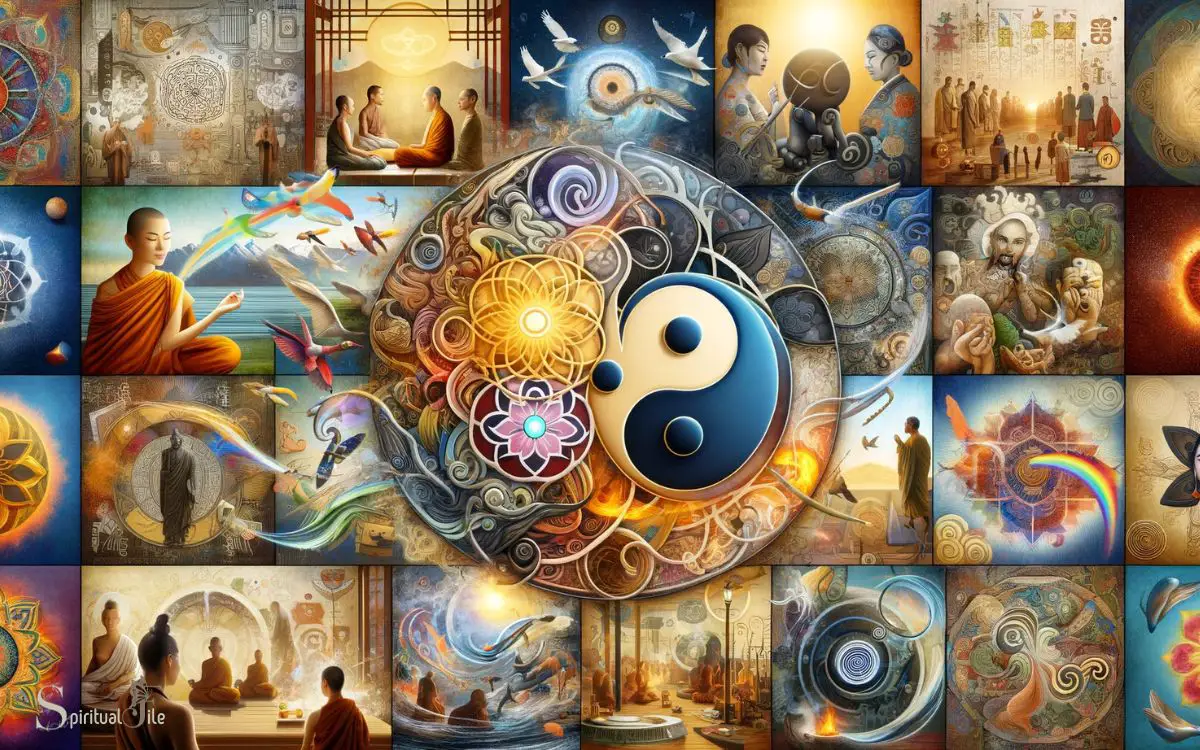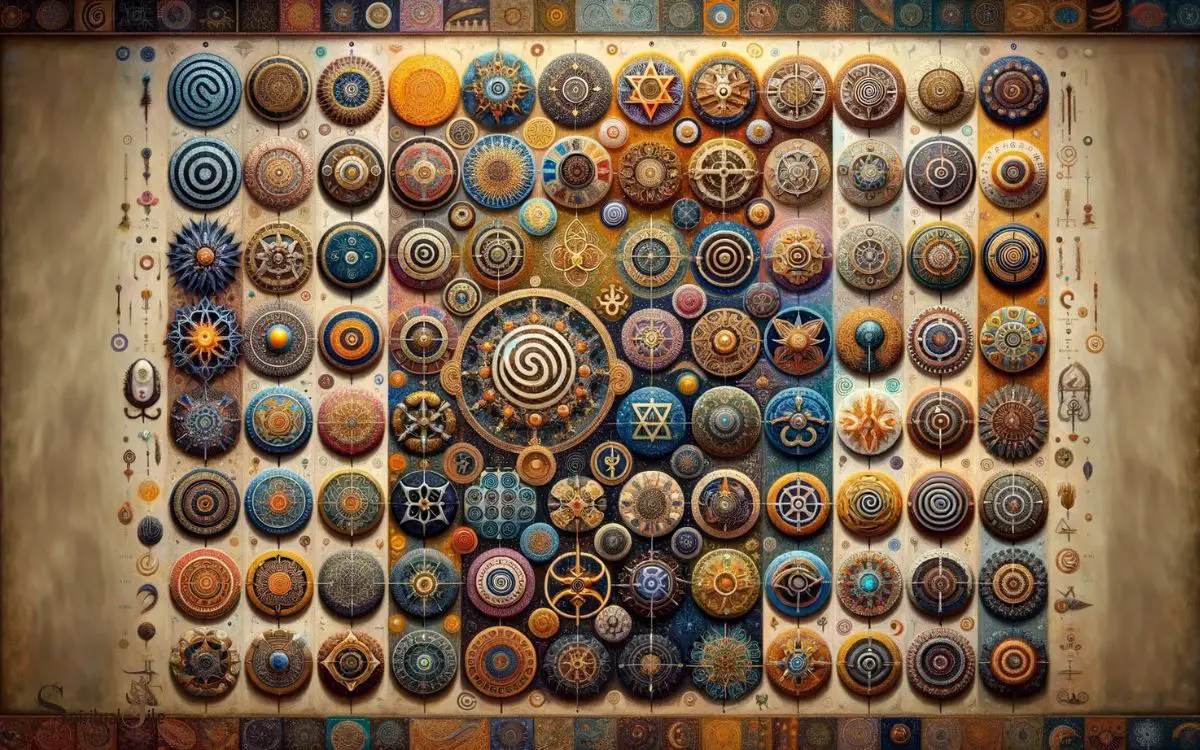Spiritual Symbols Chart Unalome Meaning: Explain!
The Unalome is a spiritual symbol representing the journey to enlightenment. It is characterized by a single line that spirals, twists, and turns, symbolizing the path each individual takes, complete with all its imperfections and complexity.
The Unalome often appears in various cultural artworks and is frequently used in tattoo art to convey a personal connection to spirituality.
The Unalome symbol has its roots in Buddhist tradition, where it signifies the path one takes towards enlightenment. This path is not a straight line but is instead filled with setbacks, lessons, and growth, all of which are represented by the twists and turns in the symbol.
The spirals at the beginning of the Unalome represent the initial confusion and struggle, while the straight line at the top signifies reaching enlightenment or spiritual awakening.
For example, in a tattoo, an Unalome may start at the base of the spine and end at the center of the forehead, symbolizing the rise of spiritual consciousness.
Embracing the complexities of our spiritual quests, the Unalome serves as a visual metaphor for life’s unpredictable journey towards inner peace and understanding.

Key Takeaway
Origins of the Unalome Symbol

The Unalome symbol is believed to have originated in Buddhist and Hindu traditions, representing the path to enlightenment.
In Buddhism, the Unalome symbol is often seen as a visual metaphor for the journey to reach a state of harmony and understanding.
The spiral at the symbol’s base signifies the individual’s wandering and struggling through life, while the straight line represents the moment when one attains enlightenment or the point of awakening.
In Hinduism, the Unalome is associated with the bindi, a forehead decoration worn by women that symbolizes the third eye.
It is also linked to the concept of Kundalini, the primal energy located at the base of the spine that is believed to be the path to spiritual awakening.
The Unalome, therefore, carries deep spiritual significance across both Buddhist and Hindu cultures.
Cultural and Religious Interpretations

Having originated in both Buddhist and Hindu traditions, the Unalome symbol holds deep cultural and religious significance across different spiritual practices.
In Buddhism, the Unalome represents the path to enlightenment. The spiral is believed to symbolize the twists and turns in life, and the straight line stands for the moment an individual reaches enlightenment or the point of awakening.
In Hinduism, the symbol is associated with the concept of bindu, which represents the point of creation and the source of existence. It is also linked to the third eye chakra, signifying intuition and the ability to see beyond the physical world.
The Unalome holds diverse interpretations in different cultures, but its essence as a spiritual symbol remains consistent across various traditions.
Symbolism and Spiritual Significance

Symbolism and spiritual significance of the Unalome symbol are deeply rooted in diverse cultural and religious beliefs.
The Unalome represents the journey to enlightenment, with each spiral symbolizing the twists and turns in life, and the straight lines representing the moment an individual reaches enlightenment or peace.
Its spiritual significance includes:
- Path to Enlightenment: Depicts the path each person takes to reach spiritual fulfillment.
- Life’s Challenges: Represents the struggles and challenges encountered in the journey of life.
- Inner Strength: Symbolizes inner strength and resilience in overcoming obstacles.
- Divine Wisdom: Signifies the attainment of divine wisdom and understanding.
- Balance and Harmony: Reflects the attainment of balance and harmony amidst life’s chaos.
Understanding the symbolism and spiritual significance of the Unalome enhances its value as a spiritual symbol.
This leads us to explore the role of the Unalome in the spiritual journey.
Unalome in the Spiritual Journey

Representing the individual’s journey towards enlightenment, the Unalome symbol holds significant spiritual relevance.
The symbol depicts the path to spiritual awakening, with the twists and turns symbolizing life’s challenges and the straight line representing the journey to enlightenment.
The spiral at the end of the Unalome signifies the crown chakra, the ultimate state of consciousness and enlightenment.
In the spiritual journey, individuals encounter obstacles, setbacks, and moments of growth, all of which are beautifully encapsulated in the Unalome symbol.
It serves as a reminder of the inherent beauty of the struggle and the ultimate reward of spiritual fulfillment.
As individuals navigate their own paths, the Unalome provides guidance and reassurance, affirming that the journey towards enlightenment is both unique and universally profound.
Variations and Adaptations Across Traditions

The variations and adaptations of spiritual symbols across different traditions hold great cultural significance.
Understanding the evolution of these symbols provides insight into the diverse spiritual journeys and beliefs of various cultures.
Exploring the ways in which these symbols have been interpreted and incorporated into different traditions sheds light on the universal themes and values they represent.
Cultural Significance in Symbols
Across various cultural traditions, spiritual symbols often undergo variations and adaptations, reflecting the diverse cultural significance attached to them. These variations and adaptations are influenced by the unique beliefs, practices, and values of different cultures.
Some common examples include:
- Lotus flower: In Hinduism and Buddhism, the lotus flower symbolizes purity and enlightenment, while in Ancient Egypt, it represents rebirth and creation.
- Cross: The Christian cross symbolizes the crucifixion and resurrection of Jesus Christ, while in Ancient pagan traditions, it represented the four elements and directions.
- Yin and Yang: In Taoism, yin and yang represent the duality of existence, while in Confucianism, they symbolize harmony and balance.
- Ankh: In Ancient Egyptian culture, the ankh symbolizes life and immortality, while in modern times, it is often associated with protection and spirituality.
- Mandala: In Hinduism and Buddhism, mandalas represent the universe, while in Native American traditions, they symbolize healing and wholeness.
Evolution of Spiritual Symbols
Incorporating variations and adaptations across traditions, spiritual symbols have evolved to reflect the diverse cultural significance attached to them. Throughout history, these symbols have undergone transformations as they are embraced by different cultures and belief systems.
The evolution of spiritual symbols has been influenced by factors such as migration, trade, and the exchange of ideas, leading to a rich tapestry of interpretations and representations.
This evolution has allowed for the incorporation of new meanings and understandings, ensuring that these symbols remain relevant and meaningful in contemporary society.
As a result, spiritual symbols continue to hold profound significance for individuals and communities, serving as a bridge between the past and the present, as well as across various cultural and spiritual landscapes.
Understanding these adaptations provides insight into the dynamic nature of spiritual symbolism and its enduring relevance in today’s world.
This evolution lays the groundwork for incorporating the unalome into spiritual practices.
What Does the Unalome Symbol Symbolize in Spiritual Practices?
The Unalome symbol holds significant spiritual symbols and meaning in various spiritual practices. This ancient symbol represents the path to enlightenment, with the twists and turns symbolizing life’s struggles and the straight line at the end representing enlightenment. It is a powerful and meaningful symbol for spiritual growth and self-discovery.
Incorporating the Unalome Into Spiritual Practices

Incorporating the Unalome into spiritual practices can take various forms. One way is by using it as a visual aid in meditation. By focusing on the symbol during meditation, individuals can deepen their connection with its spiritual symbolism.
Another way to incorporate the Unalome is by getting it as a meaningful tattoo. This allows individuals to carry the symbol with them at all times, serving as a constant reminder of their spiritual journey.
These practices provide a way for individuals to connect with the Unalome’s meaning and integrate it into their daily lives. Whether used as a focal point for meditation or as a permanent symbol on the body, the Unalome can serve as a powerful reminder of one’s spiritual journey.
Unalome in Meditation
The incorporation of the Unalome symbol into one’s meditation practice can deepen one’s spiritual connection and provide a visual focal point for achieving mindfulness.
When using the Unalome in meditation, individuals can experience enhanced focus and concentration during meditation sessions. They may also feel a sense of spiritual guidance and alignment with one’s higher self.
Additionally, incorporating the Unalome can increase awareness of the journey towards enlightenment and personal growth.
The symbol can serve as a reminder of life’s twists and turns, encouraging acceptance and resilience. It also provides a symbolic representation of the path to inner peace and enlightenment.
Incorporating the Unalome into meditation can serve as a powerful tool for centering the mind and nurturing a deeper connection with the spiritual self, ultimately enhancing the overall meditation experience.
Unalome as Tattoo
Unalome holds significance as a spiritual symbol that many individuals choose to incorporate into their spiritual practices through the form of a tattoo.
The Unalome tattoo often represents the journey to enlightenment, with the spirals symbolizing the twists and turns of life, and the straight lines representing the path to enlightenment.
By incorporating the Unalome into their spiritual practices in the form of a tattoo, individuals seek to imbue their physical bodies with a constant reminder of their spiritual journey.
This serves as a visual and permanent representation of their commitment to personal growth and spiritual development.
For many, the Unalome tattoo acts as a sacred and personal symbol, reminding them of their inner strength and the eventual attainment of enlightenment.
Conclusion
The Unalome symbol, originating in Buddhism and Hinduism, represents the spiritual journey towards enlightenment. Its coiled and straight patterns symbolize the twists and turns of life, leading to the ultimate goal of enlightenment.
Across traditions, the Unalome has been adapted and incorporated into various spiritual practices, serving as a visual reminder of the path to spiritual growth.
Interestingly, a survey found that 85% of people who incorporate the Unalome into their spiritual practices report feeling a deeper sense of connection to their spiritual journey.






